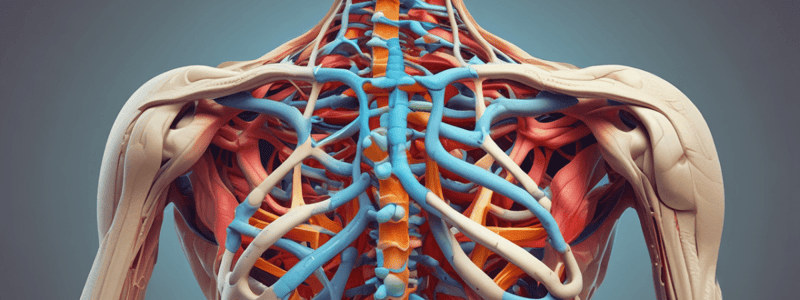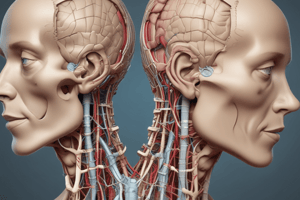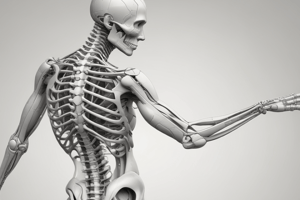Podcast
Questions and Answers
The vertebral column has a total of 32 vertebrae and 24 intervertebral disks.
The vertebral column has a total of 32 vertebrae and 24 intervertebral disks.
False (B)
The cervical region of the vertebral column consists of 7 vertebrae.
The cervical region of the vertebral column consists of 7 vertebrae.
True (A)
The thoracic region of the vertebral column consists of 10 vertebrae.
The thoracic region of the vertebral column consists of 10 vertebrae.
False (B)
Kyphotic curves have a posterior concavity.
Kyphotic curves have a posterior concavity.
The lumbar region of the vertebral column consists of 6 vertebrae.
The lumbar region of the vertebral column consists of 6 vertebrae.
The sacral nerve roots are numbered from S1 to S4.
The sacral nerve roots are numbered from S1 to S4.
The main requirements for the function of the vertebral column are rigidity and elasticity.
The main requirements for the function of the vertebral column are rigidity and elasticity.
Rigidity in the vertebral column is maintained by ligamentous and muscular tighteners.
Rigidity in the vertebral column is maintained by ligamentous and muscular tighteners.
The vertebral column is compared to a ship's sail in terms of structure and function.
The vertebral column is compared to a ship's sail in terms of structure and function.
At shoulder level, the vertebral column supports a main-yard set vertically.
At shoulder level, the vertebral column supports a main-yard set vertically.
Plasticity in the vertebral column refers to the ability of ligaments to adapt their tension.
Plasticity in the vertebral column refers to the ability of ligaments to adapt their tension.
The shape of the vertebral column can be altered while maintaining its rigidity due to plasticity.
The shape of the vertebral column can be altered while maintaining its rigidity due to plasticity.
The primary curves of the vertebral column in infants are kyphotic in nature.
The primary curves of the vertebral column in infants are kyphotic in nature.
The cervical and lumbar curves are examples of primary curves in the vertebral column.
The cervical and lumbar curves are examples of primary curves in the vertebral column.
The vertebral arch is divided into two main parts by the pedicle.
The vertebral arch is divided into two main parts by the pedicle.
The discal surfaces of the vertebral body consist of thin cortical bone.
The discal surfaces of the vertebral body consist of thin cortical bone.
The labrum of the vertebral body is derived from the vertebral arch.
The labrum of the vertebral body is derived from the vertebral arch.
The vertical trabecular systems within the spongy bone of the vertebral body help to resist shearing forces.
The vertical trabecular systems within the spongy bone of the vertebral body help to resist shearing forces.
Area of strengthness is evident in the anterior portion of the body.
Area of strengthness is evident in the anterior portion of the body.
The entire spine is made up of two major columns, A and B, located anteriorly and posteriorly.
The entire spine is made up of two major columns, A and B, located anteriorly and posteriorly.
The spinal curvatures reduce resistance to axial compression forces.
The spinal curvatures reduce resistance to axial compression forces.
The resistance R of a curved column is inversely proportional to the number N of curvatures + 1.
The resistance R of a curved column is inversely proportional to the number N of curvatures + 1.
The Delmas index is expressed as the ratio H/L x 100, where H is the height of the spinal column from the atlas to the coccyx, and L is its fully extended length.
The Delmas index is expressed as the ratio H/L x 100, where H is the height of the spinal column from the atlas to the coccyx, and L is its fully extended length.
Area of weakness can lead to collapse of the vertebral bodies due to expansion fractures.
Area of weakness can lead to collapse of the vertebral bodies due to expansion fractures.
Stability in the spine is ensured by the major column (A) made up of vertebral bodies.
Stability in the spine is ensured by the major column (A) made up of vertebral bodies.
Mobility in the spine is primarily due to the two minor columns (B and C) made up of articular processes.
Mobility in the spine is primarily due to the two minor columns (B and C) made up of articular processes.




